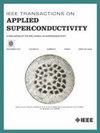Nb纳米结构的几何相关超导跃迁
IF 1.7
3区 物理与天体物理
Q3 ENGINEERING, ELECTRICAL & ELECTRONIC
引用次数: 0
摘要
最近,超导纳米结构受到了特别的关注,因为一些有趣的现象的可视化,如相位波动,量子相滑移,临界温度下的形状共振,允许定义具有所需超导特征的定制超导纳米器件,量子现象。深入研究超导、低维、量子现象之间的关系,以解释这些效应在纳米结构中的产生机制,以及超导是如何受到影响的。下面,我们报道了连接铌纳米条的三角形铌衬垫的超导跃迁的研究。根据R vs T曲线,我们观察到超导转变具有两个区域的特征:i)第一个平滑和宽的转变,反映了Nb三角形衬垫宽度的持续减小,逐渐经历超导转变;ii)一个更突然的转变,反映了Nb纳米条纹的转变。这项工作为实现具有可调临界温度、转变宽度和斜率的铌纳米结构铺平了道路。本文章由计算机程序翻译,如有差异,请以英文原文为准。
Geometry Dependent Superconductive Transition of Nb Nanostructures
Recently, superconducting nanostructures gained particular attention due to the visualisation of some intriguing phenomena, such as phase fluctuations, quantum phase slip, shape resonance in critical temperature, allowing the definition of a tailored superconducting nanodevice with the desired superconducting features, quantum phenomena. A deep investigation into the relationship between superconductivity, low dimensionality, quantum phenomena should be performed, in order to explain the emergence mechanism of these effects in nanostructures, how superconductivity is affected. In the following, we report on the investigation of the superconductive transition in triangular-shaped Nb pads connecting a Nb nanostripe. As revealed by R vs T curves, and the superconductive transition is observed to be characterised by two regions: i) a first smooth and wide transition reflecting the continuous reduction in the width of the Nb triangular pads that progressively experience superconductive transition, and ii) a more abrupt transition reflecting the transition of the Nb nanostripe. This work could pave the way concerning the realisation of Nb nanostructures with tunable critical temperature, transition width, and slope.
求助全文
通过发布文献求助,成功后即可免费获取论文全文。
去求助
来源期刊

IEEE Transactions on Applied Superconductivity
工程技术-工程:电子与电气
CiteScore
3.50
自引率
33.30%
发文量
650
审稿时长
2.3 months
期刊介绍:
IEEE Transactions on Applied Superconductivity (TAS) contains articles on the applications of superconductivity and other relevant technology. Electronic applications include analog and digital circuits employing thin films and active devices such as Josephson junctions. Large scale applications include magnets for power applications such as motors and generators, for magnetic resonance, for accelerators, and cable applications such as power transmission.
 求助内容:
求助内容: 应助结果提醒方式:
应助结果提醒方式:


